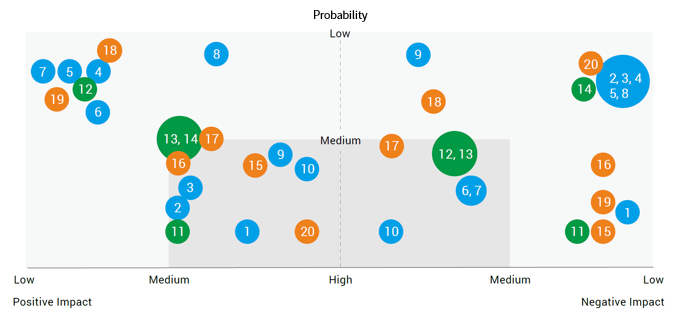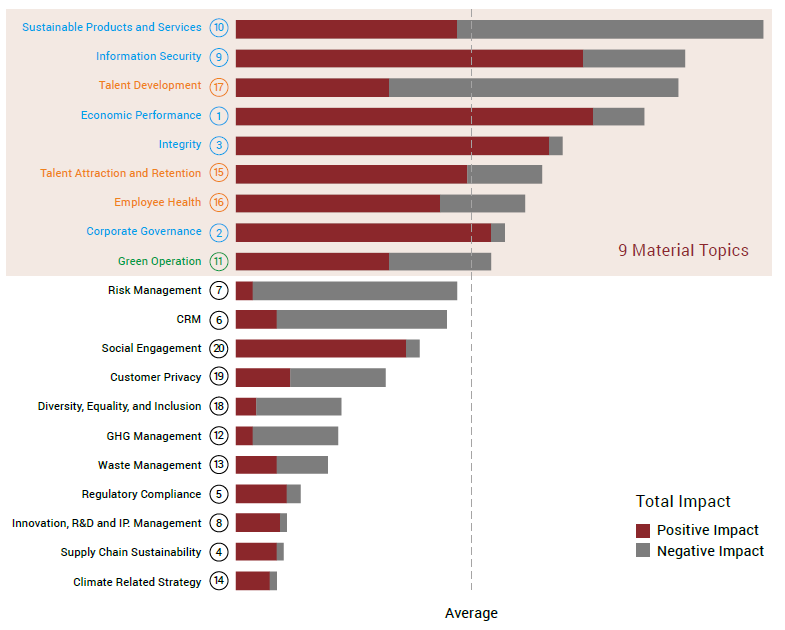Materiality Analysis & Stakeholder Engagement
Materiality Analysis
Based on the 8 reporting principles of GRI Standards, SYSTEX conducts the process of “Materiality Analysis” and collects the sustainability status to compile sustainability report and disclose its sustainable performance. After analyzing leading companies and industry-related issues, SYSTEX has compiled 20 sustainability topics and conducted a survey determined stakeholder concerns for sustainability topics. The Sustainability Group assessed impacts and probabilities, and made rankings with external experts. Finally, the CSO approved 9 material topics.
2022’s 20 sustainability topics were updated with “Intellectual Property Management” merging with “Innovation and R&D” into “Innovation, R&D and IP. Management,” “Diversity and Equality” and “Non-discrimination” into “Diversity, Equality, and Inclusion.” Human rights are now in GRI general disclosures, evaluating impacts and probabilities, and drawing a human rights risk matrix to minimize impacts. Compared with the previous year’s topics, “Sustainable Products and Services” and “Information Security” were promoted to the top 2 and newly included as the material topics; “Regulatory Compliance” was excluded because internal training and management reduced negative impacts.
At the end of 2022, SYSTEX Group has conducted a materiality analysis.
In 2023, considering that SYSTEX Group has not encountered any major business issues that would lead to drastic changes in the materiality analysis, SYSTEX has changed the materiality analysis frequency from annual to biennially starting from 2023. If any issues affecting operations occur in a year in which an analysis is not conducted, a new materiality analysis will be conducted.
For more details about climate risks, please refer to “Climate-Related Risk“.
Process to Determine Material Topics
1. Identify Material Topics
According to AA1000 SES, SYSTEX identifies 7 types of stakeholders. Following GRI standards, SASB – Software & IT Services and integrating the concerns of benchmark enterprises and stakeholders, SYSTEX has summarized 20 Sustainability Topics, which were divided into 3 aspects: economy, environment, and human capital/society.
2. Assess Importance of Stakeholders
SYSTEX sends materiality questionnaires to its executive-level and stakeholder representatives to understand the concerns of stakeholders on each sustainability topic.
3. Analyze Materiality
The Sustainability Group assessed “positive/negative impact” and “probability” of each sustainability topic, collected 10 economic, 7 environmental, and 7 social questionnaires with a total of 24 questionnaires, and drew the materiality matrix.
4. Review Disclosures
Consider concerns of stakeholders and external experts, and rank sustainability topics according to the “positive/negative impact” and “probability.” Finally, the CSO approved 9 material topics. The Sustainability Group will then refer to the GRI and list the corresponding indicators for data inventory.
Materiality Matrix and Topics
List of Sustainability Topics

Positive and Negative Impact Matrix
Reference to the “GRI 3: Material Topics 2021”, SYSTEX assessed the positive/negative impacts and possibilities of each topic. Among them, “Social Engagement,” “Sustainable Products and Services” and “Economic Performance” are topics with high positive impact, while “Sustainable Products and Services” and “Talent Development” are topics with high negative impact.
|
Topics with High Positive Impact |
|
|
Topics with High Negative Impact |
|

Ranking Material Topics
|
Changes in Material Topics |
Materiality of sustainability issues were ranked by impact, probability, and stakeholder concerns. 9 with above-average scores were chosen as material topics for the year. 2 material topics, “Sustainable Products and Services” and “Information Security” this year address the urgency for sustainable transition, customer privacy, and trade secret protection. “Regulatory Compliance” did not make the cut due to lower impact but will still be monitored for compliance with economic, social, and environmental requirements. |

Material Topics and their Meanings and Impacts on the Value Chain, and related Policies, Strategies and Grievance Mechanisms
SYSTEX Group identifies 9 material topics across “governance, environment and social”, and demonstrates the meanings of these material topics to SYSTEX, management policies, grievance mechanism and direct/indirect impacts on internal stakeholders or external stakeholders along the entire value chain, and then displays the scope of impacts on these stakeholders, identifying the types of impacts that affect them.
●: Direct impact ○: Indirect impact
| Material Topics | Meanings and Impacts | Policy and Strategy | Grievance Mechanism | SDGs | Internal | Value Chain | |||||
| SYSTEX | Affiliate | Employee | Customer | Original | Supplier | ||||||
| G | Sustainable Products and Services | SYSTEX’s sustainable solutions are beneficial to the economy, environment, and society. To remain competitive in the growing market, SYSTEX works with suppliers on innovative, sustainable solutions optimal for operations and shareholder interests. | SYSTEX aims to be the top sustainable partner for enterprise clients, providing innovative solutions and digitalized management in their sustainable transition. | The President supervises performance quarterly and sets business targets. Each BU optimizes sustainable solutions. | SDG8 |
● | ● | ○ | ● | ● | ○ |
| Information Security | As an IT service industry leader, SYSTEX prioritizes information security and safeguards business secrets and customer privacy to prevent negative impacts on stakeholders. | SYSTEX formulates IS-related regulations such as “Information Security Policy”, obtains ISO 27001 and other IS-related verifications, regularly conducts various crisis drills, and strengthens training, to improve information security risk defense capabilities. | The IS Technology Department plans employee IS training, conducts ISO 27001 annually, and performs information security drills regularly. | – | ● | ● | ● | ● | ● | ● | |
| Economic Performance | The financial performance not only has a direct impact on SYSTEX itself and its shareholders but also increases the ESG budgets for sustainable solutions. | Gather SYSTEX’s tech teams and jointly work with ecosystem partners to offer 5 types of value-added services, aiding clients in building innovative business models and creating exponential growth. | The Board of Directors, as the highest governance body, is responsible for the operation and its executive performance. | SDG8 | ● | ● | ● | ● | ● | ● | |
| Corporate Government | Based on the philosophy of integrity and transparency, SYSTEX formulates its governance mechanism to drive a positive impact. | Ensure the diversity and independence of directors through the “Rules of Election of Directors” and “Corporate Governance Best Practice Principles”. | The Board of Directors, as the highest governance body, is responsible for the operation and its executive performance. | SDG8 SDG16 |
● | ● | ○ | ○ | ○ | ○ | |
| Integrity | SYSTEX strives to be a trusted brand with a positive economic impact through strict business ethics and financial transparency. | Implement Integrity management, ask employees to sign the “Ethical Corporate Management Best Practice Principles” and arrange ethical training courses to make integrity spirit take root. Externally, suppliers are also required to sign the “Integrity Pledge and Declaration”. | The Integrity Committee is responsible for prevention measures and supervising their implementation. | SDG8 SDG16 |
● | ● | ● | ● | ● | ● | |
| E | Green Operation | The carbon emissions of the SYSTEX headquarters building mainly come from the daily use of energy, water, papers, and other resources, which are managed to reduce negative impacts on the environment. | To achieve the goal of “Net Zero by 2050”, based on 3 environment-related ISO verifications: ISO 14001, ISO 14064-1, ISO 50001. | The OHS and Energy Committee holds meetings regularly to confirm the achievement of targets. | SDG7 SDG12 SDG13 |
● | ● | ○ | ○ | ○ | ○ |
| S | Talent Attraction and Retention | Attraction and retention of key talent enhance competitiveness. Completing the talent development and benefit mechanism can increase the positive impacts on employee rights. | Launch a recruitment program to recruit talents with core capabilities. Care for new employees with “New Employee Training Courses,” “Mentor System” and “Dedicated HR Service Assistant.” Implement benefit and welfare mechanisms. | The HR Division reviews the retention of key talents and new-hires regularly, tracks the policy implementation, and investigates the reasons for employee departure. | SDG3 SDG4 SDG8 SDG10 SDG16 SDG17 |
● | ● | ● | ○ | ○ | ○ |
| Talent Development | Taiwan faces an IT talent shortage, and employees prioritize companies that offer training in the latest technologies. SYSTEX fosters tech talents with comprehensive career development to address the digital transition, mitigating employee turnover impact. SYSTEX designs targeted talent programs for different stages, enhancing digital competitiveness. | Adhering to the vision, SYSTEX offers complete information services and the robust “Employees Training and Development Rules” with performance management and continuous core HR investment. SYSTEX developed software talent programs for different learning stages to build a pool of exceptional prospects. | The HR Division provides training resources and increases the number of employee training hours internally, SYSTEX actively invests in IT education to accumulate world-class IT talents early. | ● | ● | ● | ○ | ○ | ○ | ||
| Employee Health | Work stress and long hours of sitting in the office may harm the employee’s health. Creating a safe workplace and developing health promotion programs can increase the positive impacts on employees. | Employ full-time “health managers”, set up a “health management center” and innovate “Health UP! APP” to help employees manage their health. | The health manager evaluates the employee’s medical report annually and provides consultation. | ● | ● | ● | ○ | ○ | ○ | ||
Goals for Material Topics
| Material Tops | 2023 Goal | 2023 Performance | Status | Short-term goal | Mid-term goal | Long-term goal | |
| 2024 | 2027 | 2030 | |||||
| G | Sustainable Products and Services |
|
|
Achieved |
|
|
|
| Information Security |
|
|
Achieved |
|
|
|
|
| Economic Performance |
|
|
Achieved |
|
|
|
|
| Governance |
|
|
Achieved |
|
|
|
|
| Integrity |
|
|
Achieved |
|
|
|
|
| E | Green Operation |
|
|
Achieved |
|
|
|
| S | Talent Attraction and Retention |
|
|
Achieved |
|
|
|
| Talent Development |
|
|
Achieved |
|
|
|
|
| Employee Health |
|
|
Achieved |
|
|
|
|
Stakeholder Engagement and Communication Channels
2023 SYSTES’s communication condition with stakeholders had already been reported to the boards on December 20.
| Stakeholder | Meanings of Stakeholder | Topics | Frequency and Channels | Our Responses (2023) |
| Employee | Employees are the most important partners of SYSTEX and the most important foundation for enterprise sustainability. |
|
|
|
| Customer | SYSTEX focuses on improving quality and creating exponential growth for customers. |
|
|
|
| Shareholder / Investor | The investor is the main force for SYSTEX’s steady growth. SYSTEX strives to “create max benefits for investors” and discloses transparent financial information. |
|
|
|
| Upstream Original | SYSTEX works with upstream originals to expand the market. |
|
|
|
| Supplier | SYSTEX establishes long-term partnerships with them to create greater benefits for customers. |
|
|
|
| Government | Comply with the regulations to create jobs and tax revenue sources. |
|
|
|
|
Media / Public |
The media is an important channel of communication for stakeholders. Conveying SYSTEX’s brand image to the republic will help to connect more stakeholders. |
|
|
|
Stakeholder Questionnaire
In order to understand your expectation for the sustainable development of SYSTEX Group, please click the following link to fill in the questionnaire. Thank you.
If you have any questions related to the sustainable development of SYSTEX Group, please write an email to csr@systex.com, we will reply to you as soon as possible.

